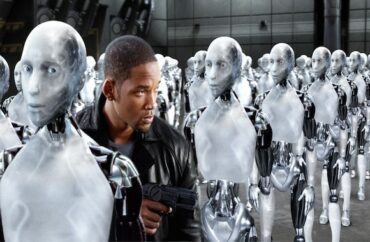
Black children ‘could end up interacting with white robots’
A professor of sociology at the University of Pittsburgh recently expressed concern over the lack of diversity among the robot population.
Mark Paterson, whose interests lie in “the history and science of bodily sensation and technologies of the senses,” notes in The Conversation that the field of “socially assistive robotics” works to “create machines that will best help people help themselves.”
But most robots don’t look like the people with whom they interact. Paterson worries, for example, that black children (who now suffer from autism at greater rates than their white peers) “could end up interacting with white robots.”
Indeed, some of the currently most popular robots — Kaspar, Nao, Pepper and iCub — all have white “skin.” Paterson says robot color schemes come from “design choices” which tend to go for a “clinical, clean look” — like “shiny white plastic.”
(The semi-hit film “I, Robot” [pictured], based on Isaac Asimov‘s classic stories, featured white-“skinned” mechanical men; many illustrations in his novels and stories, however, often had them with a silver color. Metallic hues often have been the norm in science fiction: the Cylons in both versions of “Battlestar Galactica,” Gort in “The Day the Earth Stood Still” (both versions), and the robots in the various incarnations of “Lost in Space,” the most recent of which featured a black metallic robot.)
MORE: ‘Robo-sexism’ talk at Cornell to tackle sex-gender stereotypes in robots, AI
Paterson dubs this the “poverty of the engineered imaginary,” part of other “imaginaries” which lead to how things are designed and created. In the case of robots, the design comes from the realm of science fiction, books and films.
The cultural imaginary that enshrines robots as white, and in fact usually female, stretches back to European antiquity, along with an explosion of novels and films at the height of industrial modernity. From the first mention of the word “android” in Auguste Villiers de l’Isle-Adam’s 1886 novel “The Future Eve,” the introduction of the word “robot” in Karel Čapek’s 1920 play “Rossum’s Universal Robots,” and the sexualized robot Maria in the 1925 novel “Metropolis” by Thea von Harbou – the basis of her husband Fritz Lang’s famous 1927 film of the same name – fictional robots were quick to be feminized and made servile.
 So, should more robots be built with black or brown exteriors? Not just that, Paterson says. The “poverty of the engineered imaginary” can further be overcome by delving into various cultures’ “gestures,” “expressions,” and “vocalizations,” and then incorporating them into our robotic assistants.
So, should more robots be built with black or brown exteriors? Not just that, Paterson says. The “poverty of the engineered imaginary” can further be overcome by delving into various cultures’ “gestures,” “expressions,” and “vocalizations,” and then incorporating them into our robotic assistants.
Paterson (pictured) also references women’s, gender & sexuality studies scholars Neda Atanasoski and Kalindi Vora who a year ago held a talk about how robots “intersect with race, patriarchy, colonialism and capitalism.” The former claimed robots’ “emotional expressions” come from Charles Darwin’s theory “that only white Europeans could control their emotions, while people of color could not.”
MORE: Researchers promote sex robots that can turn down sex with their owners
IMAGES: The Count of S/X; U. Pittsburgh
Like The College Fix on Facebook / Follow us on Twitter






Please join the conversation about our stories on Facebook, Twitter, Instagram, Reddit, MeWe, Rumble, Gab, Minds and Gettr.